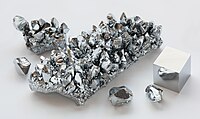
Photo from wikipedia
The composition and stratification of the passive oxide films formed on three Cr-Fe-Co-Ni(-Mo) multi-principal element alloys by electrochemical anodic passivation in sulfuric acid electrolyte containing 0.2 and 4.7 M NaCl… Click to show full abstract
The composition and stratification of the passive oxide films formed on three Cr-Fe-Co-Ni(-Mo) multi-principal element alloys by electrochemical anodic passivation in sulfuric acid electrolyte containing 0.2 and 4.7 M NaCl were investigated, combining X-ray photoelectron spectroscopy and time-of-flight secondary ion mass spectrometry surface analysis. The passive films show a bilayer structure similar to that formed in Cl--free electrolyte with an inner layer mostly consisting of Cr oxide and an outer layer containing of Cr hydroxide, Ni hydroxide, Mo oxides, and Fe (hydr)oxide. The Mo-free alloy exhibits a thickening of the inner Cr oxide layer and the thinning of the outer layer at 0.2 M Cl-, whereas the two Mo-containing alloys do not show significant alteration even at 4.7 M Cl- evidencing their higher stability in Cl--containing solutions. The chloride penetration is limited to the external part of the outer oxide layer, except in the most severe tested conditions where traces reach the inner barrier layer, and the chloride entry into the layer is strongly reduced after pre-passivation in Cl--free solution. The results allow us to discuss the beneficial effects of pre-passivation in Cl--free conditions and Mo addition providing these alloys enhanced resistance to passivity breakdown.
Journal Title: Journal of The Electrochemical Society
Year Published: 2023
Link to full text (if available)
Share on Social Media: Sign Up to like & get
recommendations!